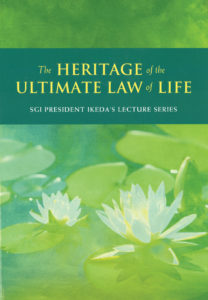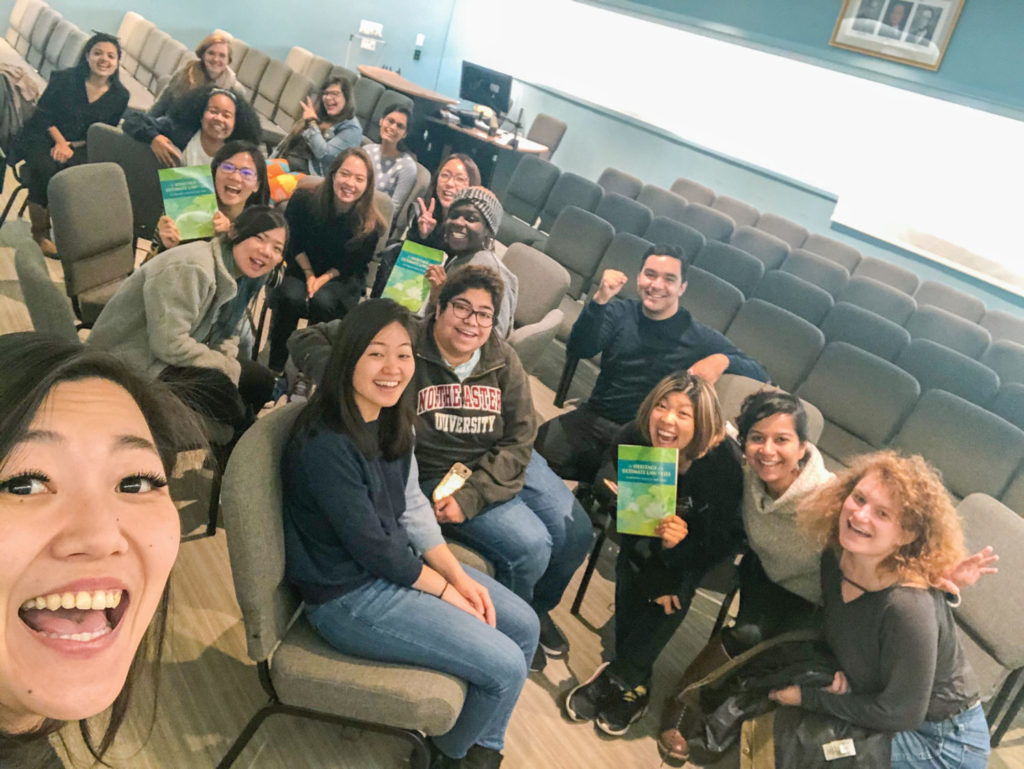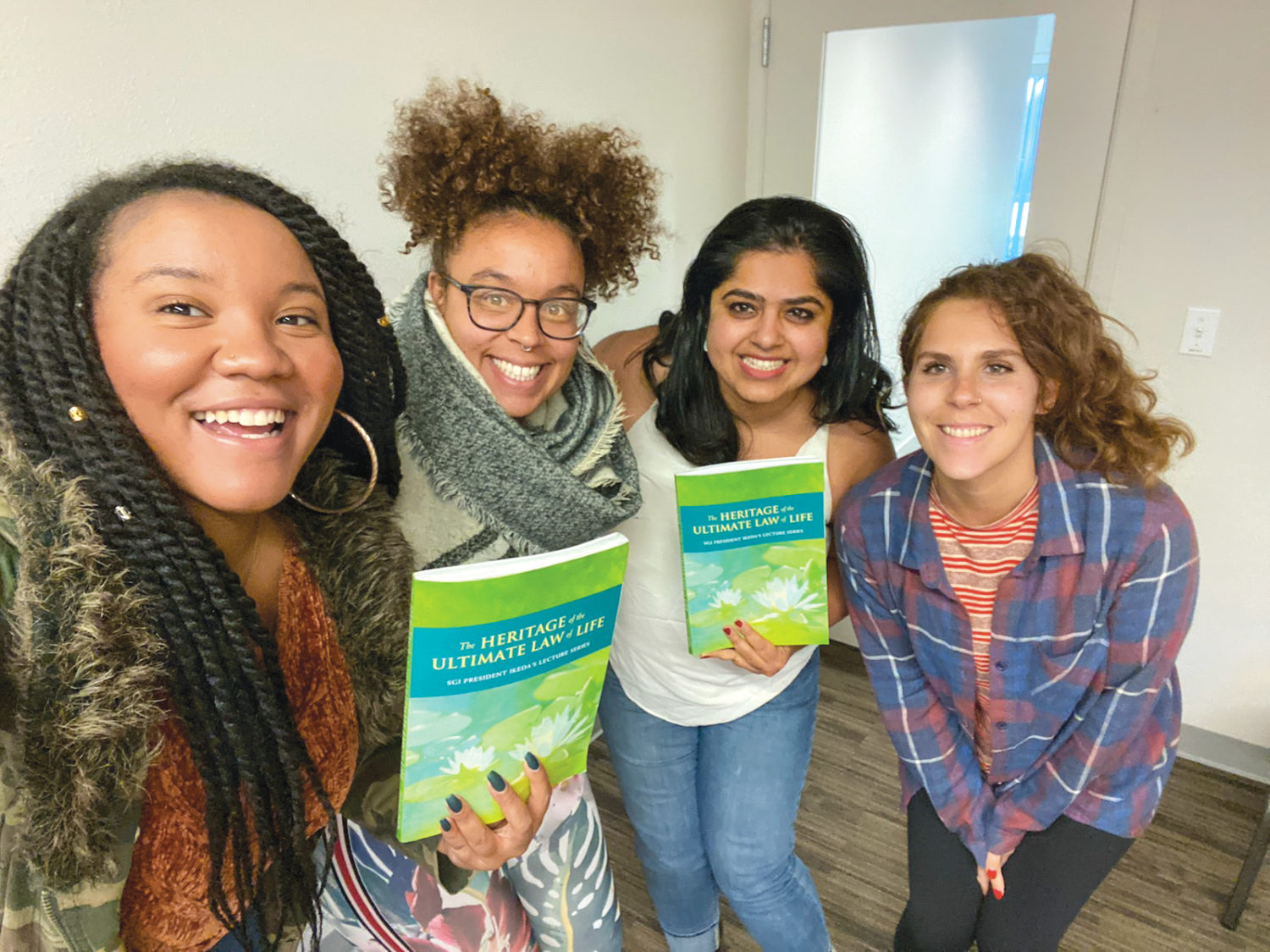The Ikeda Wisdom Academy is an SGI-USA youth division movement to engage youth leaders in advanced study. This month, academy members will study chapter 7 of The Heritage of the Ultimate Law of Life: SGI President Ikeda’s Lecture Series.
While the Ikeda Wisdom Academy is a youth leaders study program, all SGI-USA members are invited to utilize this section of Living Buddhism as a guide for their personal study of “The Heritage of the Ultimate Law of Life.”
– – – – – – – – – – – – – – – – – – – – – – – – – – – –
Syllabus – January 2020
The Heritage of the Ultimate Law of Life: SGI President Ikeda’s Lecture Series, Chapter 7
– – – – – – – – – – – – – – – – – – – – – – – – – – – –

Chapter 7
Maintaining Lifelong Faith—Our Faith in This Lifetime Secures Our Happiness Over the Three Existences

Nichiren Daishonin explains that by continuing in our Buddhist practice and deepening our faith until the last moment, we can ensure victory in this lifetime and all future existences.
Life Throughout the Three Existences—Past, Present and Future
My followers are now able to accept and uphold the Lotus Sutra because of the strong ties they formed with it in their past existences. They are certain to obtain the fruit of Buddhahood in the future. The heritage of the Lotus Sutra flows within the lives of those who never forsake it in any lifetime whatsoever—whether in the past, the present, or the future. But those who disbelieve and slander the Lotus Sutra will immediately “destroy all the seeds for becoming a Buddha in this world” [see The Lotus Sutra and Its Opening and Closing Sutras, p. 110]. Because they cut themselves off from the potential to attain enlightenment, they do not share the heritage of the ultimate Law of life and death. (“The Heritage of the Ultimate Law of Life,” The Writings of Nichiren Daishonin, vol. 1, p. 217)
Nichiren Daishonin says: “My followers are now able to accept and uphold the Lotus Sutra because of the strong ties they formed with it in their past existences. They are certain to obtain the fruit of Buddhahood in the future” (WND-1, 217). It is his unequivocal assertion that our strong connection with the Lotus Sutra in past lifetimes is the cause that has enabled us to embrace the sutra in this lifetime, an act that in turn serves as the cause for our attaining Buddhahood in future existences as well. These words are specifically meant as encouragement for the letter’s recipient, Sairen-bo, who was trying to practice the Lotus Sutra while in exile. But they can also be read as an affirmation that, through positively transforming our lives in this existence, we can positively transform the totality of our lives—that is, all lifetimes throughout past, present and future.
In terms of chronological sequence, we can readily appreciate that changes made in this existence will affect our future lifetimes. It may be a little more difficult, however, to grasp that such changes can have an impact on our past lifetimes, too. Also, though we speak of transforming the cycle of birth and death, this doesn’t mean putting an end to it. When we embrace the Lotus Sutra in our present existence, we come to deeply appreciate that past rounds of birth and death in the realm of suffering and delusion are like a dream, and that life and death as functions of the Mystic Law—that is, birth and death in the realm of Buddhahood—are the actual awakened reality. This is the true aspect of life clearly perceived by the Buddha.
Human beings usually think of the world of suffering as being their actual reality. But from the standpoint of the original and inherent nature of life and death, this world of suffering is akin to a dream. In his writing titled “The Unanimous Declaration by the Buddhas of the Three Existences,” Nichiren describes the birth and death experienced in the nine worlds as a dream realm, and the eternal and unchanging world of Buddhahood as the true, awakened realm. He writes:
One should also understand that one’s own mind that views the dream realm of birth and death in the nine worlds is no different from the waking mind of the world of Buddhahood, the world that is eternal and unchanging. The place in which one views the dream realm of birth and death in the nine worlds is no different from the place in which one experiences the waking state of the world of Buddhahood, eternal and unchanging. There is no difference in the mind itself, and no difference in the place where all this occurs. But the dreams are all false or empty, while what is experienced in the waking state is all true. (WND-2, 846)
When we look at our past lifetimes from the truly awakened state of life derived through embracing the Mystic Law in the present, we can recognize that we must have had strong ties with the Lotus Sutra from the past. Having a connection with the Lotus Sutra means that by hearing the teaching that enables all people to attain enlightenment, our innate Buddha nature has been activated. This connection can be either positive or negative, so the “strong ties with the Lotus Sutra” (see WND-1, 217) of which Nichiren speaks in this writing are not limited to a positive relationship. Whether we embrace faith in the Lotus Sutra or reject it, in either instance our Buddha nature is stimulated.
Our connection with the Lotus Sutra in past lifetimes is the cause for us to embrace the sutra in the present, and by continuing to do so until the final moment, we will leave this world with a correct and steadfast mind of faith. This lifetime, therefore, serves as the cause for our attaining the fruit of Buddhahood in subsequent lifetimes, too. (The Heritage of the Ultimate Law of Life: SGI President Ikeda’s Lecture Series, pp. 62–64)
The Law of Cause and Effect—Everything Ultimately Hinges on the Present
If you want to understand the causes that existed in the past, look at the results as they are manifested in the present. And if you want to understand what results will be manifested in the future, look at the causes that exist in the present. (WND-1, 279)
I was deeply struck when I first read these words in my youth, because they drove home to me that, when it comes to cause and effect, nothing is more important than the present and our own faith. This sutra passage and Nichiren’s related explanation in “The Opening of the Eyes” clarify that the essence of the Buddhist view of causality lies in changing one’s present self. We see Nichiren express both unassailable confidence in the ability to transform any negative karma from the past, and boundless hope in the certainty of enjoying immense happi-ness in future lifetimes, all achieved as a result of his present actions for the sake of the Law (see WND-1, 287).
Nichiren Buddhism enables each of us to establish a solid self in the present so that we can transform past sorrows and misery into inexhaustible hope for the future. The heart of Nichiren’s teaching is that no matter what difficulties we may now face, we should earnestly challenge the present with unflagging optimism and the belief that we can change the future.
In any event, our faith, our Buddhist practice, in this existence determines the direction of all of our lifetimes throughout past, present and future, whether they will be pervaded by happiness and compassion or by sorrow and darkness. (Lecture Series, 64)
Continued Faith Secures Our Course Over the Three Existences
A vital aspect of our Buddhist practice lies in continuing it throughout our lives. In his “Letter to Niike,” Nichiren Daishonin emphasizes the importance of maintaining faith to the very end:
Be diligent in developing your faith until the last moment of your life. Otherwise you will have regrets. For example, the journey from Kamakura to Kyoto takes twelve days. If you travel for eleven but stop with only one day remaining, how can you admire the moon over the capital? (WND-1, 1027)
This is a well-known passage. Though having had the great good fortune to embrace Nichiren Buddhism, if we stop practicing before we reach the end of our lives, we cannot attain the ultimate summit of Buddhahood. Since the flame of Buddhist practice is easily extinguished, Nichiren urges us to remain diligent in developing our faith.
Why is the flame of faith easily extinguished? Because people allow themselves to be defeated by the desire for fame and fortune or by onslaughts of the three obstacles and four devils. Nichiren says: “Strengthen your faith day by day and month after month. Should you slacken in your resolve even a bit, devils will take advantage” (“On Persecutions Befalling the Sage,” WND-1, 997). A slackening or wavering in our resolve or faith triggers our fundamental darkness, our negativity. To maintain faith throughout our lives, therefore, rests on our resolve to keep on striving in our Buddhist practice. (Lecture Series, 65)

Boston IWA
Deepening Our Faith Day by Day
From this perspective, I affirm that all SGI members are certain to enjoy lives of victory based on faith.
In terms of Nichiren Daishonin’s view of life and death—the Buddhist view of life’s eternity—it is clear that the moment of death is the culmination of our present lifetime. This is because it represents not only the final page of this existence but also the departure toward the next.
Nichiren specifically stresses the importance of “first learning about death” (see “The Importance of the Moment of Death,” WND-2, 759). And President Toda often said, “The purpose of our Buddhist practice is for the sake of our final moment.”
Therefore, it is a basic premise in Nichiren Buddhism that unceasing faith means faith that grows deeper “day by day and month after month” (WND-1, 997) until the closing page of one’s life. Indeed, we need to strongly bear in mind that we must continue to deepen our faith. (Lecture Series, 65–66)
A Life of Self-Realization, Social Contribution and Victory
Faith is something that should continue to deepen over the course of a lifetime. In terms of a lifelong commitment to human development and spiritual growth, let us look at the example found in ancient India. Prior to Shakyamuni’s time, it had become customary to view life as divided into four distinct periods. These are known as the four ashramas, or stages of life.
The first stage is that of the student (brahmacari). This is the period for studying under a teacher to become an educated and well-rounded individual.
The second stage is that of the householder (grihastha). This is the period for taking on responsibility in society and family life.
The third stage is that of the retiree (vanaprastha). This is the period for detaching oneself from the pursuit of worldly wealth and status, for retiring and focusing on religious practice.
The fourth stage is that of the renunciant (sannyasi). This is the period for discarding attachments and embarking on a journey toward spiritual enlightenment and emancipation from the sufferings of birth and death.
In other words, the people of ancient India followed a four-stage path of developing themselves, assuming social and family responsibilities, focusing on religious practice and realizing the ultimate meaning of life. This essentially sums up how they lived their lives.
With a similar lifelong commitment to faith, we of the SGI are today forging ahead with self-realization, social contribution and victory in life as our goals.
■ ■ ■
The Record of the Orally Transmitted Teachings states: “The words ‘four sides’ [of the treasure tower] stand for birth, aging, sickness, and death. We use the aspects of birth, aging, sickness, and death to adorn the tower that is our body” (OTT, 90). The Lotus Sutra says that when the treasure tower appeared, all of its four sides emitted a sweet fragrance. Nichiren here explains that these four sides are none other than birth, aging, sickness and death, which adorn our lives with their beautiful fragrance. This interpretation of the four universal sufferings as a life-adorning fragrance is truly profound. (Lecture Series, 66–67)
You are reading {{ meterCount }} of {{ meterMax }} free premium articles

